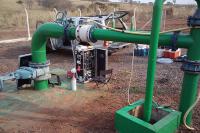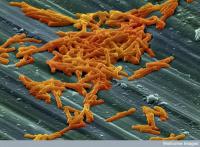-
Pulling water from air
Researchers are tackling the world’s water crisis by pulling water out of the air. Their result is the patent-pending Hybrid Atmospheric Water Generator (HAWgen), which generates clean drinking water from the atmosphere through the integration of sorption, refrigeration and water filtration systems.
-
-
What Flint’s water crisis could mean for the rest of the nation
Elevated levels of lead in the drinking water in Flint, Michigan, brought to light not only the troubles of one city but also broader concerns about the nation’s aging water distribution system. Noted scientist is calling for federal funding to replace deteriorating lead pipes in large swaths of the United States.
-
-
For young engineers, Flint offers a lesson on the importance of listening
Sheldon Masters, a former Virginia Tech Ph.D. student, says he used to think scientists and engineers should be like robots: “Emotionally unattached.” But after attending a class entitled “Engineering Ethics and the Public: Learning to Listen” with dozens of other young engineers at his university, he found his perspective changed. Developed with support from a National Science Foundation (NSF) grant, the course is intended to explore the relationship between engineering, science, and society.
-
-
Can drinking water be delivered without disinfectants like chlorine and still be safe?
When we open the tap, we expect the water to be safe. That is, the water should be free of pathogens that could make us sick and any chemicals that could cause problems later in life. For the most part, potable water systems in the developed world have done a great job providing safe water. However, there are still unfortunate situations that develop, resulting in issues with the safety of drinking water. One of the conclusions of the research we have conducted is that potable water systems should consider moving beyond carrying a disinfectant and focus instead on maintaining and replacing their aging delivery systems and upgrading their water treatment steps. This will have the benefit of limiting exposure to DBP while also continuing to deliver safe water to consumers.
-
-
Water pipes crawl with millions of bacteria
Researchers have discovered that our drinking water is to a large extent purified by millions of “good bacteria” found in water pipes and purification plants. So far, the knowledge about them has been practically non-existent, but this new research is about to change that.
-
-
Rigid water pipes, fit for the future
Water infrastructures – such as pipes, sewers, or water storages – are rigid systems. They are renewed according to certain renovation cycles. This can take up to 70 years for municipal sewage systems and up to 30 years for baths in rental apartments. “That has to be considered when creating concepts for the future of the water infrastructure,” says Dr.-Ing. Thomas Hillenbrand, scientist at the Fraunhofer Institute.
-
-
Contamination in North Dakota linked to fracking spills
Accidental wastewater spills from unconventional oil production in North Dakota have caused widespread water and soil contamination, a new study finds. Researchers found high levels of ammonium, selenium, lead and other toxic contaminants as well as high salts in the brine-laden wastewater, which primarily comes from hydraulically fractured oil wells in the Bakken region of western North Dakota.
-
-
Climate change redistributes global water resources
Rising temperatures worldwide are changing not only weather systems, but - just as importantly - the distribution of water around the globe, according to a new study. This study marked the first time scientists have used specific measurements to demonstrate how water sources are changing, especially in the northeastern United States.
-
-
We’re (not) running out of water – a better way to measure water scarcity
Water crises seem to be everywhere. In Flint, the water might kill us. In Syria, the worst drought in hundreds of years is exacerbating civil war. But plenty of dried-out places aren’t in conflict. For all the hoopla, even California hasn’t run out of water. There’s a lot of water on the planet. What is critical is managing water to meet current and future demand. Biophysical indicators, such as the ones we looked at, can’t tell us where a water shortage is stressful to society or ecosystems, but a good biophysical indicator can help us make useful comparisons, target interventions, evaluate risk and look globally to find management models that might work at home.
-
-
Bacteria may help keep water cleaner
Phosphorus is a crucial nutrient regularly applied to crops such as corn and soybeans to help them grow efficiently. However, excess phosphorus can be carried by rainwater runoff into lakes and streams, creating potential problems for aquatic environments and the ecosystem services they provide to humans. To combat this problem, researchers are trying to better understand two groups of bacteria that could affect whether phosphate is retained in the soil or becomes mobile and gets into the water.
-
-
Groundwater extraction contributes less to sea level rise than previously thought

Groundwater extraction and other land water contribute about three times less to sea level rise than previous estimates, according to a new study. The study does not change the overall picture of future sea level rise, but provides a much more accurate understanding of the interactions between water on land, in the atmosphere, and the oceans, which could help to improve future models of sea level rise.
-
-
New paper filter removes viruses from water

More than 748 million people around the world lack access to safe drinking water and basic sanitation. Water-borne infections are among the global causes for mortality, especially in children under age of five, and viruses are among the most notorious water-borne infectious microorganisms. They can be both extremely resistant to disinfection and difficult to remove by filtration due to their small size. Scientists have developed a simple paper sheet which can improve the quality of life for millions of people by removing resistant viruses from water.
-
-
Rapid detection of E. coli in water
Tragedies like the E. coli outbreak in Ontario’s Walkerton in May 2000 could be averted today with a new invention by researchers at York University that can detect the deadly contaminant in drinking water early. Anew technology has cut down the time taken to detect E. coli from a few days to just a couple of hours.
-
-
Changing land uses in California will drive water needs beyond available supply
If past patterns of California land-use change continue, projected water needs by the year 2062 will increase beyond current supply. If historical trends of land use changes to or from urban, agricultural or other uses continue, the result will be increased water-use demand beyond what existing supplies can provide. Large uncertainties associated with weather and climate variability have the potential to exacerbate the problem.
-
-
With drought easing, California rolls back water conservation rules
California announced on Wednesday that it was rolling back mandatory water conservation rules which were put in place at the height of a 4-year drought. The decision to roll back the restrictions came after water conditions in many parts of the state have improved as a result of a wet winter.
-
- All
- Regional
- Water
- Biometrics
- Borders/Immig
- Business
- Cybersecurity
- Detection
- Disasters
- Government
- Infrastructure
- International
- Public health
- Public Safety
- Communication interoperabillity
- Emergency services
- Emergency medical services
- Fire
- First response
- IEDs
- Law Enforcement
- Law Enforcement Technology
- Military technology
- Nonlethal weapons
- Nuclear weapons
- Personal protection equipment
- Police
- Notification /alert systems
- Situational awareness
- Weapons systems
- Sci-Tech
- Sector Reports
- Surveillance
- Transportation
Advertising & Marketing: advertise@newswirepubs.com
Editorial: editor@newswirepubs.com
General: info@newswirepubs.com
2010-2011 © News Wire Publications, LLC News Wire Publications, LLC
220 Old Country Road | Suite 200 | Mineola | New York | 11501
Permissions and Policies
Editorial: editor@newswirepubs.com
General: info@newswirepubs.com
2010-2011 © News Wire Publications, LLC News Wire Publications, LLC
220 Old Country Road | Suite 200 | Mineola | New York | 11501
Permissions and Policies
